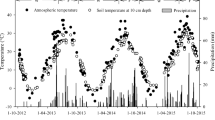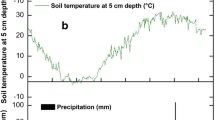Abstract
Black Vertosols of subtropical Australia emit large amounts of nitrous oxide (N2O) to the atmosphere under fertilizer-applied grain cropping compared to other Australian cropping soils. N2O emissions can be mitigated by either reducing fertilizer N inputs or altering crop rotation systems. In this study, the WNMM agroecosystem model was used to investigate the responses of N2O emissions from four different crop rotation systems including canola-wheat-barley (T1CaWB), chickpea-wheat-barley (T3CpWB), chickpea-wheat-chickpea (T4CpWCp), and chickpea-Sorghum (T5CpS) under projected future climate change scenarios on a black Vertosol at Tamworth, New South Wales, Australia. In simulations of the twenty-first century under four different scenarios for atmospheric greenhouse gas concentrations, the annual N2O emissions from the four cropping systems increased with greenhouse gas forcing of the climate. The annual N2O emissions from T4CpWCp (with no fertilizer N application) were the most sensitive to climate change, with 14.3–61.9% increase compared with historic simulations of 1952–2014. The simulated T5CpS treatment (with a long fallow) kept the gross margin-scaled N2O emissions below 1 g N per Australian dollar under all climate change scenarios. This suggests that the inclusion of a long fallow in a crop rotation system can slow down the pace of increasing gross margin-scaled N2O emissions in response to climate change. Our simulation results also imply that legume rotations as mitigation options on N2O emissions may not be resilient to the future changing climate even though they can greatly reduce N2O emissions under the current climate.


Similar content being viewed by others
References
Anwar MR, Liu DL, Farquharson R, Macadam I, Abadi A, Finlayson J, Wang B, Ramilan T (2015) Climate change impacts on phenology and yields of five broadacre crops at four climatologically distinct locations in Australia. Agric Syst 132:133–144
Arnold JG, Kiniry JR, Srinivasan R, Williams JR, Haney EB, Neitsch SL (2012) Soil & Water Assessment Tool Input/Output Documentation Version 12. Texas Water Resources Institute, TR-439, 654 p
Bijay-Singh, Ryden JC, Whitchead DC (1988) Some relationships between denitrification potential and fractions of organic carbon in air-dried and field-moist soils. Soil Biol Biochem 20:737–741
Cure JD, Acock B (1986) Crop responses to carbon dioxide doubling: a literature survey. Agric For Meteorol 38:127–145
DCC (Department of Climate Change) (2010) National Inventory Report 2008—volume 1. The Australian Government Submission to the UN Framework Convention on Climate Change May 2010. Department of Climate Change, Canberra 297 p
Dijkstra FA, Prior SA, Runion GB, Torbert HA, Tian H, Lu C, Venterea RT (2012) Effects of elevated carbon dioxide and increased temperature on methane and nitrous oxide fluxes: evidence from field experiments. Front Ecol Environ 10:520–527
Dodla SK, Wang JJ, DeLaune RD, Cookc RL (2008) Denitrification potential and its relation to organic carbon quality in three coastal wetland soils. Sci Total Environ 407:471–480
Firestone M, Davidson E (1989) Microbial basis of NO and N2O production and consumption. In: Andreae MO, Schimel DS (eds) Exchange of trace gases between ecosystems and the atmosphere. John Wiley, Chichester, pp 7–21
Friedlingstein P, Prentice IC (2010) Carbon–climate feedbacks: a review of model and observation based estimates. Curr Opin Environ Sustain 2:251–257
Gagnon B, Ziadi N, Rochette P, Chantigny MH, Angers DA (2011) Fertilizer source influenced nitrous oxide emissions from a clay soil under corn. Soil Sci Soc Am J 75:595–604
Halvorson AD, Del Grosso SJ, Alluvione F (2010) Nitrogen source effects on nitrous oxide emissions from irrigated no-till corn. J Environ Qual 39:1554–1562
IPCC (2013) Climate change 2013: the physical science basis. Contribution of working group I. In: Solomon S, Qin D, Manning M, Chen Z, Marquis M, Averyt KB, Tignor M, Miller HL (eds) Fourth assessment report of the intergovernmental panel on climate change. Cambridge University Press, Cambridge, p 996
Isbell RF (2002) The Australian Soil Classification, Revised edn. CSIRO Publishing, Melbourne
Jeffrey SJ, Carter JO, Moodie KB, Beswick AR (2001) Using spatial interpolation to construct a comprehensive archive of Australian climate data. Environ Model Softw 16(4):309–330
Li Y, Chen D, White R, Zhang J, Li B, Zhang Y, Huang Y, Edis R (2007) A spatially referenced Water and Nitrogen Management Model (WNMM) for (irrigated) intensive cropping systems in the North China Plain. Ecol Model 203:395–423
Li Y, Barton L, Chen D (2012) Simulating the response of N2O emissions to fertilizer N application and climatic variability from a rain-fed and wheat-cropped soil in Western Australia. J Sci Food Agric 92:1130–1143
Li Y, Wang WJ, Reeves S, Dalal RC (2013) Simulation of N2O emissions and mitigation options for rainfed wheat cropping on a Vertosol in the subtropics. Soil Res 51(2):152–166
Liu DL, Zuo H (2012) Statistical downscaling of daily climate variables for climate change impact assessment over New South Wales, Australia. Clim Chang 115(3–4):629–666
Ludwig F, Asseng S (2006) Climate change impacts on wheat production in a Mediterranean environment in Western Australia. Agric Syst 90(1):159–179
Manzoni S, Taylor P, Richter A, Porporato A, Ågren GI (2012) Soil carbon and nitrogen mineralization: theory and models across scales. New Phytol 196:79–91
Millar N, Ndufa JK, Cadisch G, Baggs EM (2004) Nitrous oxide emissions following incorporation of improved-fallow residues in the humid tropics. Glob Biogeochem Cycles 18:GB1032
Palm CA, Alegre JC, Arevalo L, Mutuo PK, Mosier AR, Coe R (2002) Nitrous oxide and methane fluxes in six different land use systems in the Peruvian Amazon. Glob Biogeochem Cycles 16:GB1073
Ravishankara AR, Daniel JS, Portmann RW (2009) Nitrous oxide (N2O): the dominant ozone-depleting substance emitted in the 21st century. Science 326:123–125
Rochette P, Janzen HH (2005) Towards a revised coefficient for estimating N2O emissions from legumes. Nutr Cycl Agroecosyst 73:171–179
Roels JA (1980) Application of macroscopic principles to microbial-metabolism. Biotechnol Bioeng 22:2457–2514
Schwenke GD, Herridge DF, McMullen KG, Haigh BM (2014) Legumes in crop rotations reduce soil nitrous oxide emissions compared with fertilized non-legume rotations. In: Heng LK, Sakadevan K, Dercon G, Nguyen ML (eds) 2012 Proceedings—international symposium on managing soils for food security and climate change adaptation and mitigation, Vienna, Austria. FAO, Rome, pp 235–241
Sinsabaugh RL, Manzoni S, Moorhead DL, Richter A (2013) Carbon use efficiency of microbial communities: stoichiometry, methodology and modelling. Ecol Lett 16:930–939
Taylor KE, Stouffer RJ, Meehl GA (2012) An overview of CMIP5 and the experiment design. Bull Am Meteorol Soc 93(4):485–498
van Groenigen JW, Velthof GL, Oenema O, van Groenigen KJ, van Kessel C (2010) Towards an agronomic assessment of N2O emissions: a case study for arable crops. Eur J Soil Sci 61:903–913
van Groenigen KJ, Osenberg CW, Hungate BA (2011) Increased soil emissions of potent greenhouse gases under increased atmospheric CO2. Nature 475:214–216
van Vuuren DP et al (2011) The representative concentration pathways: an overview. Clim Chang 109:5–31
Venterea TR, Maharjan B, Dolan MS (2011) Fertilizer source and tillage effects on yield-scaled nitrous oxide emissions in a corn cropping system. J Environ Qual 40:1521–1531
Walter K, Don A, Fuß R, Kern J, Drewer J, Flessa H (2015) Direct nitrous oxide emissions from oilseed rape cropping—a meta-analysis. GCB Bioenergy 7:1260–1271
Wang WJ, Dalal RC, Moody PW (2004) Soil carbon sequestration and density distribution in a Vertosol under different farming practices. Aust J Soil Res 42:875–882
Wang J, Wang E, Luo Q, Kirby M (2009) Modelling the sensitivity of wheat growth and water balance to climate change in Southeast Australia. Clim Chang 96(1–2):79–96
Wei XR, Hao MD, Xue XH, Shi P, Horton R, Wang A, Zhang YF (2010) Nitrous oxide emission from highland winter wheat field after long-term fertilization. Biogeosciences 7:3301–3310
Wrage N, Velthof GL, Laanbroek HJ, Oenema O (2004) Nitrous oxide production in grassland soils: assessing the contribution of nitrifier denitrification. Soil Biol Biochem 36:229–236
Xu R, Prentice IC, Spahni R, Niu HS (2012) Modelling terrestrial nitrous oxide emissions and implications for climate feedback. New Phytol 196:472–488
Zaehle S, Dalmonech D (2011) Carbon–nitrogen interactions on land at global scales: current understanding in modelling climate biosphere feedbacks. Curr Opin Environ Sustain 3:311–320
Acknowledgements
This research was financially supported by the NSW Department of Primary Industries.
Author information
Authors and Affiliations
Corresponding author
Electronic supplementary material
ESM 1
(DOCX 938 kb)
Rights and permissions
About this article
Cite this article
Li, Y., Liu, D.L., Schwenke, G. et al. Responses of nitrous oxide emissions from crop rotation systems to four projected future climate change scenarios on a black Vertosol in subtropical Australia. Climatic Change 142, 545–558 (2017). https://doi.org/10.1007/s10584-017-1973-5
Received:
Accepted:
Published:
Issue Date:
DOI: https://doi.org/10.1007/s10584-017-1973-5




